Walk into a modern “smart classroom” and you’re likely to be greeted by a dazzling array of technology — interactive whiteboards, high-resolution projectors, tablet-based learning, AI-powered assessment tools, and seamless internet connectivity. The chalkboard has given way to touchscreens; rows of static desks have evolved into flexible seating arrangements.
But beyond the sleek devices and glowing screens, the question remains — are smart classrooms truly smarter, or are they simply more technologically equipped?
What Defines a Smart Classroom?
A smart classroom is essentially a technology-enhanced learning space designed to improve teaching effectiveness and student engagement. Typical features include:
- Interactive whiteboards replacing traditional chalkboards
- Digital content libraries accessible in real time
- Audio-visual aids like projectors, smart TVs, and document cameras
- Student devices such as tablets or laptops connected to the school network
- Cloud-based platforms for assignments, grading, and collaboration
- AI tools for personalized learning analytics
The goal isn’t just to add technology for the sake of modernisation, but to make the learning process more interactive, personalised, and efficient.
The Promises of Smart Classrooms
- Engagement Through Interactivity: Dynamic visuals, interactive quizzes, and gamified lessons capture attention far better than static lectures. A well-designed smart lesson can transform a dull history topic into a vivid virtual tour of ancient civilizations.
- Personalised Learning Paths: AI-driven systems can track individual progress and suggest tailored exercises, ensuring that a fast learner isn’t held back — and a struggling student gets extra support.
- Access to Global Resources: Students aren’t limited to their textbook. They can watch expert lectures from across the world, access up-to-date research, or even collaborate with peers internationally.
- Real-Time Feedback: Digital tools can instantly grade quizzes or highlight areas needing improvement, reducing the feedback gap that often slows traditional learning.
The Reality Check
While the benefits are compelling, the smart classroom concept isn’t without its challenges:
- Tech without Training Falls Flat: A smartboard is only as effective as the teacher using it. Without proper training, the technology risks becoming an expensive whiteboard.
- Over-Reliance on Devices: Excessive screen time and reduced face-to-face interaction can impact attention spans and social skills if not balanced.
- Infrastructure Gaps: In regions with unstable internet or limited budgets, maintaining high-end tech is difficult. The “smart” advantage may widen educational inequality.
- Data Privacy Concerns: With cloud storage and analytics comes the responsibility of protecting student data — a growing challenge in the age of cyber threats.
Smart Classrooms vs. Smart Teaching
The heart of the matter is this: Technology doesn’t automatically make education better — good teaching does. A passionate, well-trained teacher using even basic tools can create a richer learning experience than a poorly-designed smart classroom. Technology should enhance teaching, not replace the human connection that drives real understanding.
Making Smart Classrooms Truly Smart
For schools and institutions looking to invest in smart classrooms, here are key success factors:
- Teacher Training First — Equip educators with both technical skills and digital pedagogy.
- Balanced Integration — Blend technology with traditional methods to maintain human interaction.
- Student-Centric Design — Use tools that cater to different learning styles and paces.
- Continuous Upgrades — Technology evolves rapidly; smart classrooms need regular updates to remain relevant.
- Clear Learning Goals — Tech should serve educational objectives, not be a distraction.
Conclusion
So, are smart classrooms really smarter? They can be — but only when technology is thoughtfully integrated, teachers are empowered, and the focus stays on learning outcomes, not flashy gadgets.
A smart classroom isn’t defined by the equipment it holds, but by how effectively it uses those tools to inspire curiosity, encourage collaboration, and help students think critically. In that sense, the “smartness” lies not in the hardware, but in the minds it shapes.









Be the first one to comment on this story.